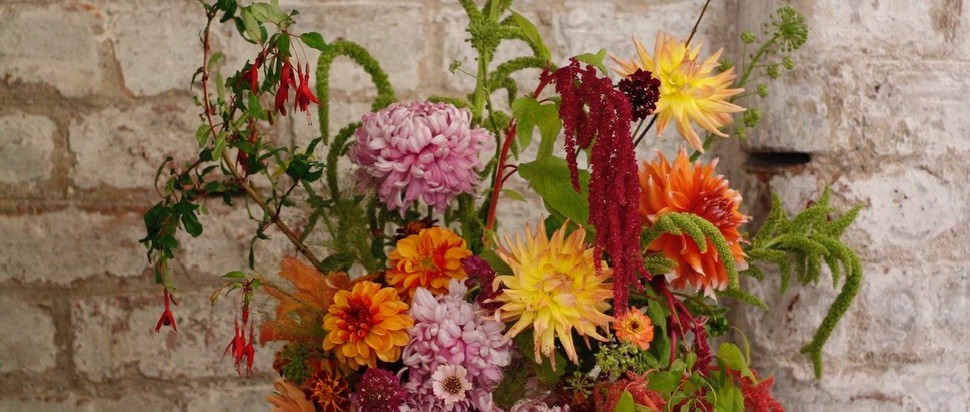Business in Bloom: Scotland's florals in flux
A nice bunch of flowers never goes amiss – but this isn't quite your usual bouquet. As spring arrives, we speak to some of the leading practitioners in Scotland's evolving florals industry
It’s idyllic, really: a neatly trimmed garden, floppy hat, iced tea in one hand, pruning shears in the other – and a perfectly ribboned bouquet to show for the afternoon’s leisure. This prim and proper vision of floristry and botanicals is an aged, misguided one, firmly put to rights by Scotland’s innovative practitioners experimenting in all things floral.
“It’s so physical,” says Fiona Inglis of Pyrus. “It’s very labour intensive.” In 2011, Inglis and Natalya Ayers founded Pyrus, an East Lothian-based botanical studio and cut flower garden. Now working with a small team, Pyrus sells to wholesalers and florists, as well as creating designs and installation art for events.
The inception of Pyrus coincided with the rise of Instagram and Pinterest, encouraging experimentation through cross-pollination of ideas and practices. “Coming from art college, you had that slightly more rebellious streak where you wanted to try different things and break rules,” says Inglis. Certainly, Pyrus has since redefined the industry in Scotland. Branches, seedlings, stones, mosses, seaweed – anything from and of the land finds a place. “We’ve been known to use the odd skull,” she says.
Glasgow-based Sophie Mahandru of Studio Kumari didn’t envision florals as a career path. While volunteering at a community garden throughout university, she picked up the basics. Graduating as the pandemic hit, Mahandru applied for Universal Credit; the slim “financial freedom” allowed her to take on unpaid work assisting freelancers working in florals and botanicals, before founding Studio Kumari.
Mahandru’s practice – florals and creative direction – encompasses installation, events, set design, and styling. Bright pink and orange blooms, understated single-stemmed arrangements, fresh wreaths; Mahandru’s work plays with floral expectations, often bringing in the odd cake, candle, or vegetable. “Nature does nature. I don't feel I have to re-create nature,” says Mahandru. “I like fashion, architecture, paintings. I think that's far easier to draw on when you've got something that's larger than just a bouquet.” Spatial designer, botanical stylist, land artist – as practitioners depart from traditional floristry, new titles create new possibilities.
The practice itself demands collaboration – with nature and with each other. Whether it’s an installation for a brand or bouquets for a wedding, practitioners often employ other freelancers to lend a helping hand. Community grows from there. “They love what they do and maybe that just makes you a happy person who wants to share and support other people,” says Inglis. Within the florals industry, there’s a unity fostered through a genuine appreciation for each other’s work. “It's not just Scotland – it's all over the world,” she adds, reflecting on past warm welcomes in New Zealand and America.
However, as Mahandru says, the industry is already “very saturated”. Brand or event work is all-too often London-based, offering limited opportunities for Scotland-based practitioners. Such limitations don't exactly help with its historic diversity issue. “It is a very white, middle class industry on the whole,” continues Mahandru. Access to a garden, specifically one in which you’re able to grow and cut from, is an increasingly rare privilege which allows those lucky few to develop their practice. Others may embark on a “career course”, usually costing a few grand, something many don’t exactly have to hand. Florals, therefore, can become somewhat exclusive. “The only way we change that is if we allow knowledge sharing and don’t hoard information or resources,” Mahandru adds.
It’s an uncertain time for the industry. As many flowers sold in the UK are imported from the Netherlands, Brexit will likely see stems increase in price. Nowadays, Mahandru notes, practitioners are often working from studios, rather than retail premises. As everyday necessities' prices are hiked further and further out of reach, our collective spending power is limited. “Flowers aren’t essential."
Of course, the climate crisis is also “such a dark cloud” for Pyrus and the industry at large. “We’re having to work out ways to be adaptable because the weather is so unpredictable and so extreme,” says Inglis. Nowadays, Pyrus can no longer rely on a select number of crops and strains due to the uncertainty of each year’s weather – it’s uncharted terrain.
But the industry also has a responsibility towards the environment: less plastic packaging, more local growing. Supermarket flowers may suffice for a scarily low price, but their environmental cost is a burdensome one due to heavy pesticide use and travel emissions. For Inglis, perceptions of locally grown flowers can be troublesome – “old fashioned, short-stemmed, weedy, lesser quality.” In reality, shorter travel distances means fresher flowers. Adopting the environmental option isn’t a compromise, it's simply a lot better.
Amid demise and decay, we’re keen to bring ourselves closer to nature, even if just for a moment. “It’s really beautiful to have a changing palette – as soon as you get fed up with using one material, the seasons change,” says Inglis. It’s an impermanent practice, by nature. Flowers sprout, bloom, die – and Scotland’s floral industry is re-imagining each and every second.
Follow Fiona Inglis @pyrusbotanicals and Sophie Mahandru @studiokumari on Instagram
